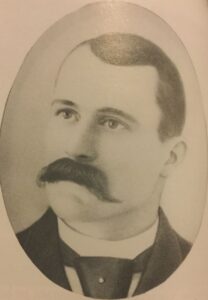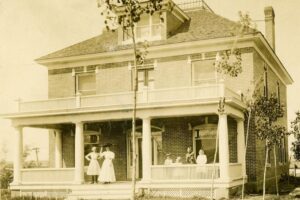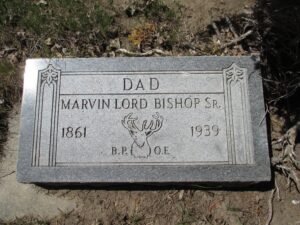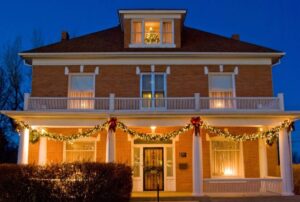
 As the westward movement progressed different areas began to emerge as important places along the trail to places like Utah, Oregon, and California. One of those important places, as it turns out, was Casper, in what would one day be the state of Wyoming. On the journey west, water was essential, and so the wagon trains often followed and even crossed the rivers as the terrain necessitated. Because the future city of Casper was located on the banks of the North Platte River, it was a logical location for a town, that later became a city. In order to locate a cut through the Rocky Mountains, the Platte River proved to be the key.
As the westward movement progressed different areas began to emerge as important places along the trail to places like Utah, Oregon, and California. One of those important places, as it turns out, was Casper, in what would one day be the state of Wyoming. On the journey west, water was essential, and so the wagon trains often followed and even crossed the rivers as the terrain necessitated. Because the future city of Casper was located on the banks of the North Platte River, it was a logical location for a town, that later became a city. In order to locate a cut through the Rocky Mountains, the Platte River proved to be the key.
As the trail of emigrants made their way across the continent, Casper was formed, and a man named John Baptist Richard could see that the river could be a necessity as a water source, but also a hinderance in that crossing it wasn’t always easy. A ferry had been established in 1847 to get emigrants across the Platte River on their way west on the Oregon-California Trail, but later Richard two bridges were erected in the 1850’s to improve the passage of settlers on their westward march. The first bridge was built in 1851 just east of present-day Casper, in the area of present-day Evansville. The second bridge became much more successful bridge and was built in 1859-1860. This bridge came to be known as the “Platte Bridge” and was a important mark on the Oregon-California trail. Later, with the establishment of the Platte Bridge Station in 1858, renamed Fort Caspar by the military in 1864 the fort and the bridge were major forces that contributed to the formation of Casper. Fort Caspar was abandoned in 1867, but the town of Casper remained, and was prosperous.
The military no longer needed the fort, and shortly thereafter, the bridges burned by the Indians. A short time later, white settlers began to develop the area. It turned out that the area was perfect for ranching. From the 1860’s through the 1880’s large cattle ranches were established near Casper. Ranches such as the Sun Ranch on the Sweetwater, the Goose Egg Ranch of the Seebright Brothers at Bessemer Bend, the Carey Ranch near the old Platte Bridge, and the Brooks Ranch east of modern-day Casper dotted the landscape.
It was about this time that John Merritt and C W Eads learned of this railroad expansion. It is believed that they were the first to arrive in what would eventually be known as Casper. On the afternoon of June 7, 1888, they pitched a tent at a spot near what is today known as McKinley and “A” Streets and established the town of Casper. As the city grew, this area would become known as “Old Town.” The town grew slowly and for two decades was one of a number of small villages dotting the plains serving local cattle operations. As in most frontier towns, the standard businesses were quickly established…four saloons and restaurants, three livery stables, one grocery store, and two general stores. As was also common, most buildings were frame construction. At that time, there were fewer than a thousand people living in the town. Marvin Lord Bishop Sr moved to Casper, Wyoming on September 1, 1892, after being appointed postmaster by President Grover Cleveland the 22nd President of the United States and a member of the Democratic Party. He later changed his affiliation to the Republican Party. His party affiliation resulted in his appointment to this prestigious position of postmaster in the developing community of Casper. While he was not the first postmaster, he was the first person to stay in the position for more than two years and is credited with bringing stability and permanence to the office as the fledgling community developed. The postmaster was on duty from 7:00am to 9:00pm…so much for bankers hours there. The salary ranged from $50.00 to $100.00 per month which would be between $1750 and $3500 today…not a bad wage, especially considering that little mail was handled in those early days. Trips to town were not an everyday occurrence for the ranchers, so when they came in, about every four months, their first stop was often the post office to get the mail that had accumulated since the last visit or since a neighbor had last brought it to them.
In addition to the post office, Mr Bishop also had a small store attached to the post office, that he also operated. It was called M. L. Bishop’s Cash Store for “Fine Family Groceries” and was one of the few businesses established in Casper in the 1890s. Bishop also helped to establish one of the earliest churches in Casper, the First Methodist Episcopal Church, now known as the First United Methodist Church. He was one of five men in Casper who met in the early spring of 1893 to discuss the importance of establishing a religious community in the developing town of Casper and to formulate plans for the formation of this church. In 1896, the church had 22 members, out of which the Bishop family, now numbering six, held a significant presence.
Because the position of postmaster was a political patronage position, Bishop began to make plans for his future, in the event of a political climate change. In May 1894 he entered into sheep ranching, purchasing land from Edward T David, another early pioneer and foreman for the Carey Ranch. His resignation as Postmaster in August 1898 began a period of 40 years when M L Bishop became a woolgrower with holdings in the Pathfinder Dam area southwest of Casper and the owner of the sheep shearing pens located at Casper Creek. Over the years, and due to some twists of fate, like the Civil War, and the movement of wool growing from the East to the Western plains and mountains, brought much wealth to the Bishop family. With Bishop’s businesses were thriving and he decided to purchase land at 818 East Second Street for a new home in 1906. He bought two adjacent lots on East Second Street in Casper in the Capitol Hill Addition from another early pioneer, Robert White. The contractor for the Bishop Home was W T Evans, founder of Evansville, Wyoming. Mr Evans built numerous other buildings in the burgeoning town of Casper such as the Town Hall in 1890 and the Saint Mark’s Episcopal Church in 1891. In addition, he built the first one-story, four-room brick home at First and Wolcott streets for his daughter and son-in-law in the late 1890’s. This home was considered one of the largest homes in Casper until Mr. Evans built the two and one-half story Bishop home with fifteen rooms. The Bishop house, built in 1907, is believed to be his first venture into large-scale, multi-story family homes.
By 1929, the year the stock market crashed, the oil boom was coming to an end, also. The boom had been furious, powerful, and seemingly endless, and before it faded from sight, that boom had made Casper, Wyoming what it was and largely what it remains today. Always a “boom and bust” town, Casper would survive whatever came its way.
In 1938, Bishop was elected County Commissioner and his years of accumulated knowledge of sheep ranching were recorded that same year by the Wyoming Works Progress Administration (WPA). He died the following year. With his death, the strains on the economy from the great depression, and the decline in the Wyoming sheep production, the family could not maintain the ranch and shearing pens. Wyoming. Bishop’s wife, Leona, continued to live in the home until her death in 1948. In total the couple had ten children. All children resided in Wyoming and were prominent in their communities with the exception of one daughter who died in infancy. T
 heir youngest daughter, Lucile L Bishop, lived in the family home from the time of her birth in October 1908 until her death in 1997. Then, the M L Bishop House was placed on the National Register of Historic Places because of its association with the development of Casper and the surrounding area from a small village to a livestock center, and eventually, to an oil town. The home is still open for tours, and I plan to go in the near future.
heir youngest daughter, Lucile L Bishop, lived in the family home from the time of her birth in October 1908 until her death in 1997. Then, the M L Bishop House was placed on the National Register of Historic Places because of its association with the development of Casper and the surrounding area from a small village to a livestock center, and eventually, to an oil town. The home is still open for tours, and I plan to go in the near future.


Leave a Reply